
Initially viewed as a way to share stories with internet users, in recent years, blogs have become one of the most profitable online marketing strategies for businesses around the world.
So, what is a blog, and what makes it different from a regular website?
We will answer these questions by taking a look at their definition, common types, and what you need to know to start a blog.
The content on a blog usually comes in the form of articles on individual web pages called blog posts. The article you’re reading is one such example.
Why Do You Need a Blog?
When blogs first emerged, people used them mainly for sharing personal information, such as their experiences and interests. For example, the coiner of the weblog term Jorn Barger used to publish essays written on internet culture and technology trends on his Robot Wisdom website.
A blog’s function remains the same until today, though the type of content is much more diverse. While many still start a blog for personal reasons, some people start blogging to educate others on a specific subject or build a professional online presence.
For instance, publishing consultant Jane Friedman blogs about the business of writing. While the purpose is to help aspiring authors land a book deal, the blog also brands her as a thought leader in the industry.

Many organizations and businesses also use blogs as a marketing channel. Their content usually focuses on industry-related information that may interest their target market. In this case, a team of multiple writers usually runs the blog instead of a single admin.
The Difference Between a Blog and a Website
This section will talk about what is a blog and how it is different from a typical website.
A blog works to present new content periodically, while a regular site provides static information about a person, a group, or a subject.
Let’s use Reedsy’s company website as an example.

The main content consists of pages that inform visitors about the company’s writing and editing services. Such information can remain unchanged for a long time unless the situation calls for an update.
Meanwhile, the blog section has new blog posts added every few days to educate readers about book writing and publishing. Automatically, the blog usually experiences more frequent updates compared to the company website.
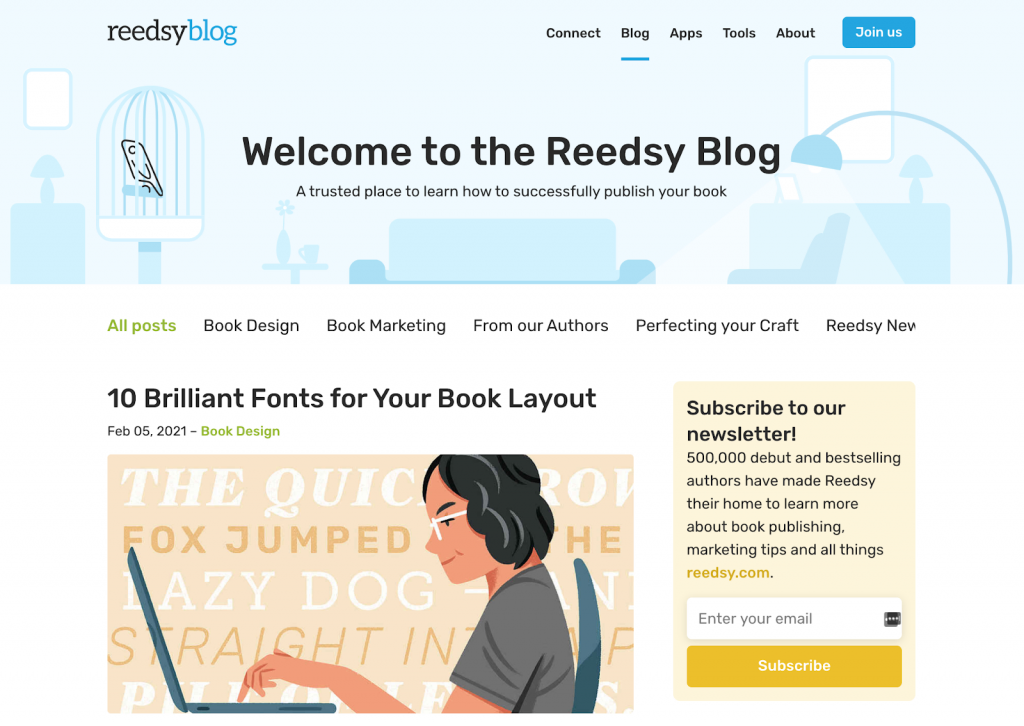
Additionally, blog posts usually have a comment section where a line of communication can be created between the readers and the author. This element is uncommon for a typical web page, as it doesn’t generally encourage audience engagement.
Benefits of Having a Blog
Looking at blogging on a smaller-scale, the main benefit of starting a blog is the ability to connect with like-minded people. That said, there are other advantages you may gain by taking blogging to the next level.
With the right strategy, blogging allows you to build an audience, which can open up various opportunities, including monetization. We will talk more about how bloggers make money later in the article.
Additionally, blogging is a great way to establish a personal brand. In fact, many professionals today have succeeded in landing jobs thanks to blogging. A blog that showcases your skills and knowledge can make you stand out from the crowd and convince employers of your credibility.
For a business, blogging is an excellent method to improve a website’s online visibility.
Reports have shown that websites with a blog have 434% more indexed pages in search engines. As a result, their chances for ranking on the first pages of SERPs and gaining organic website traffic are much higher.
Seeing this, it’s easy to understand why blog posts are the number one content type for raising brand awareness. With more people checking out your blog, the likelihood of acquiring new customers will be higher too.
Other than that, company websites with a blog section can earn 97% more backlinks than those without. Inbound links are essential to increase a site’s domain authority and cement a brand as an industry authority.
Finally, blogging and SEO make for a cost-effective marketing strategy. Marketers don’t have to spend as much money on blogs as they usually do on online advertising.
What’s more, statistics show that prioritizing blog content can result in a 13 times higher chance of gaining a positive return on investment.
5 Types of Blogs With Examples
Now that we have discussed the benefits of blogging, let’s get started with the five common types of blogs and their examples. Note that it’s also possible to classify a blog as more than one category.
1. Personal Blog
With this type of blogging site, the focus is more on the blogger than the audience themselves. The writer will usually create journal-like entries or commentaries about their lives, interests, or hobbies.
Since this type of blog is for personal use, it rarely covers only a single topic. The blogger may choose to discuss a wide range of subjects, so long as they’re within the writer’s interests.
A good example of this type of blog website is Design for Mankind. The owner Erin Loechner writes articles about her family, work projects, and self-reflection.
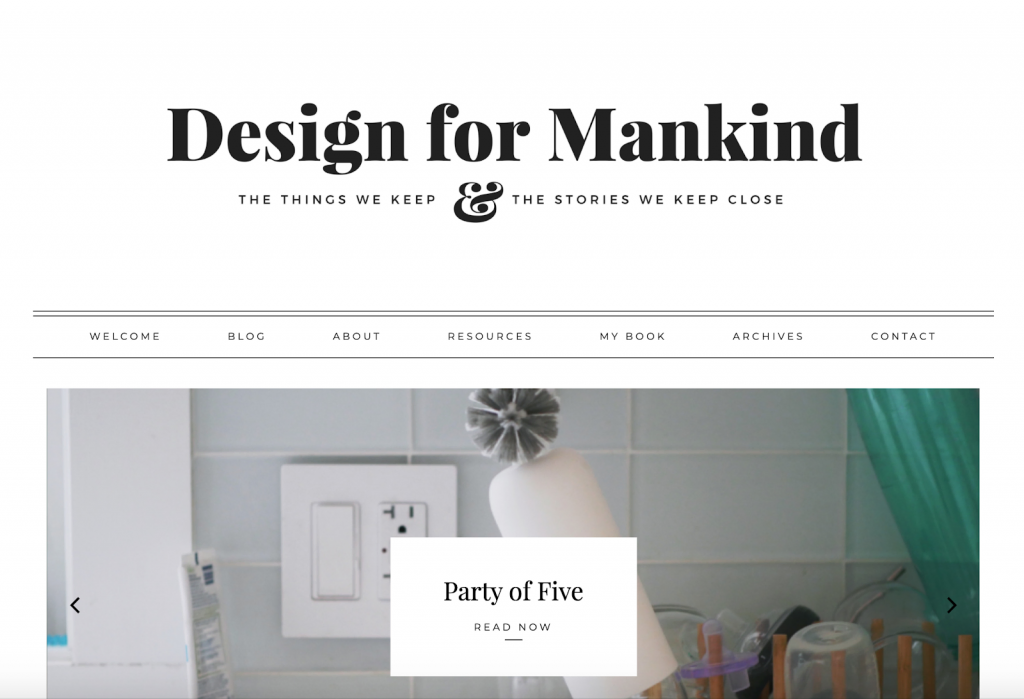
Another example is Neil Gaiman’s online journal. This blog focuses on the author’s latest projects and updates from his life.
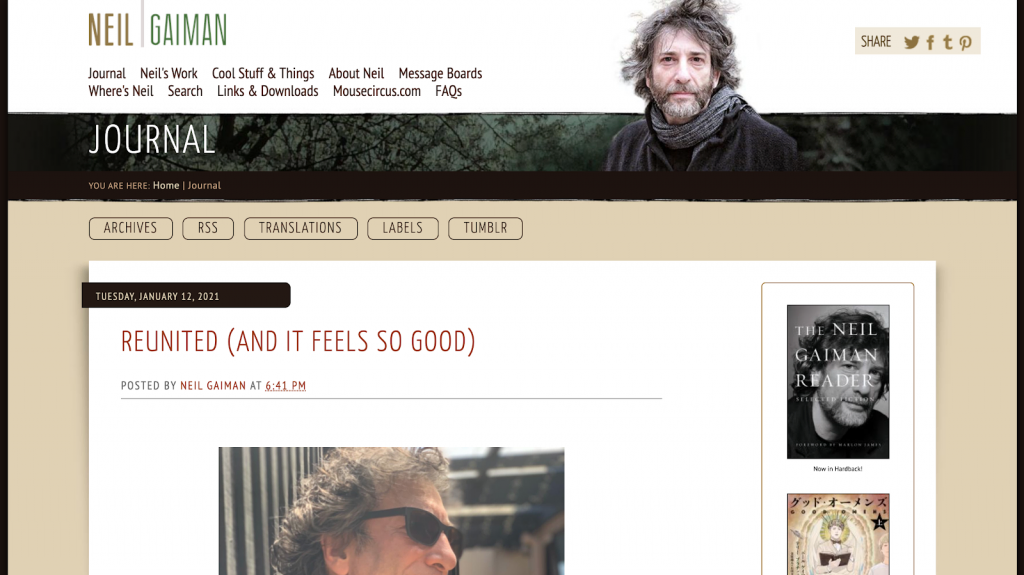
2. Niche Blog
A niche blog sticks to a particular range of topics, usually related to the blogger’s passions, skills, and knowledge. For instance, if you’re an avid reader, your blog can exclusively talk about book-related content.
The scope of the niche depends on the blogger’s preferences. Using the book blogging example, the writer can narrow it down further by focusing on only one or two genres.
The following niches are quite popular in the blogging community:
- Travel blogs. Bloggers within this category share stories about their trips, give tips to fellow travelers, and provide destination guides. A famous example is The Blonde Abroad, which centers around solo female travel.
- Fashion blogs. This niche is about the latest clothing trends, styling tips, and buying guides. Check out Jordan Bunker’s menswear blog for a better understanding.
- Health and wellness blogs. Common types of articles within this niche include listicles of exercises, nutrient-rich recipes, and tips on how to take care of your mental health. A well-known blog in this category is Fit Bottomed Girls.
- Food blogs. In this niche, the blogger may share recipes, restaurant guides, or kitchen equipment reviews. A great example of a food blog is The Minimalist Baker, which focuses on cooking instructions using ten ingredients or less.
- Personal finance blogs. This niche revolves around money management, ranging from budgeting tips to side income ideas. The Penny Hoarder is an excellent blog in this category.
- Lifestyle blogs. This niche mixes multiple topics related to the blogger’s interests, such as fashion with beauty or food with travel. A good example is A Cup of Jo – a lifestyle blog on style, design, and motherhood.
3. Company or Business Blog
This type of blog refers to any company website that has a blog section.
The primary purpose is to attract the target market by publishing content relevant to their interests or concerns. Some businesses also use blogs to update users regarding any changes within their organization.
An excellent example of a business blog is the one by Mailchimp. It provides marketing tips and resources on utilizing its digital marketing software.
Additionally, it covers successful case studies of clients using their tools, which is a great way to demonstrate their business’s utility.
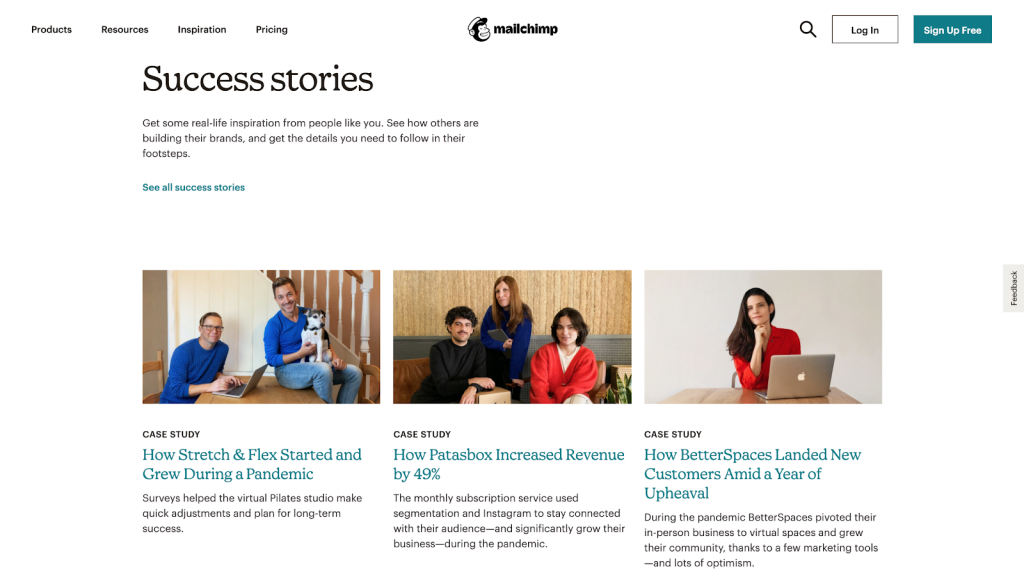
The productivity software Toggl also has an excellent business blog. The blog posts focus on subjects relevant to their features, such as hiring, team management, company culture, and project planning.
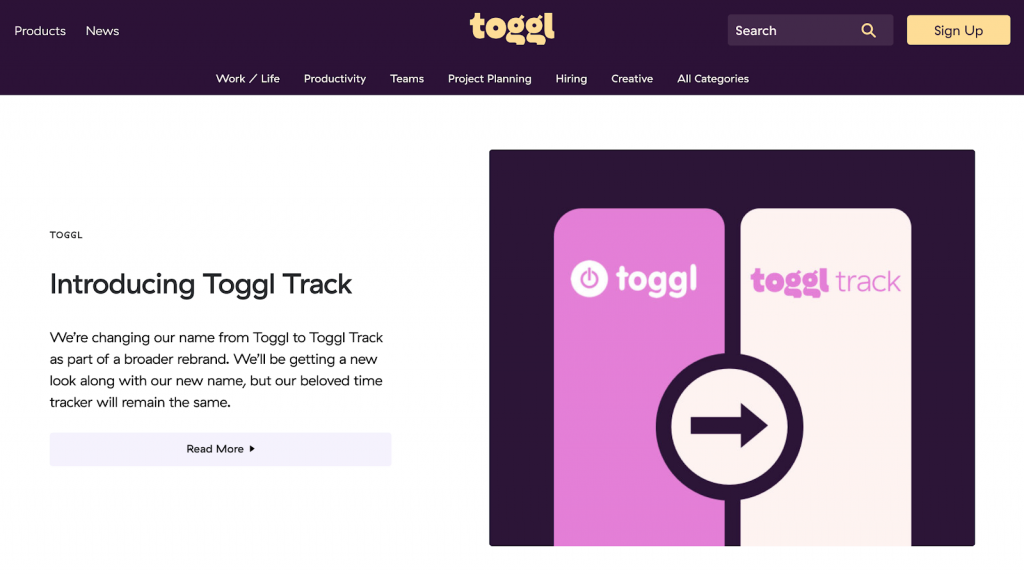
4. Affiliate Blog
This type of blog is based on affiliate marketing – the practice of promoting a third party’s products and services on an online platform.
The blogger usually provides a link on their blog posts directing users to the business’s online store. When someone clicks on it and makes a purchase, the blog owner will receive a commission.
The typical articles you can expect on an affiliate blog include product reviews, buying advice, or “best-of” listicles.
Some affiliate blogs may focus on a niche, like Outdoor Gear Lab. This WordPress website only conducts reviews on outdoor travel equipment and mainly features products from Amazon.
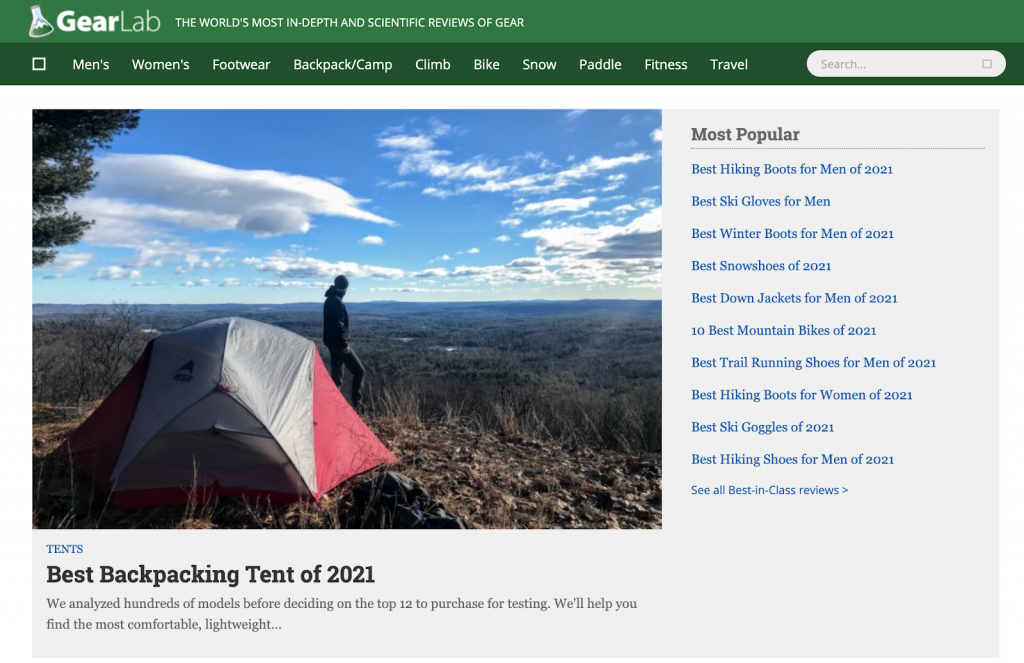
There are also affiliate blogs that feature products from various categories, such as New York Times’ The Wirecutter.

5. Reverse Blog
In a reverse blog, the content originates from multiple guest writers rather than the owner of the blog. The owner may produce articles of their own, but their primary job is to moderate and edit incoming submissions.
This type of blog is popular among freelance writers as it’s great for building their network and increasing their exposure. Some blogs may also compensate them financially for each article they have written.
One example of a reverse blog is The Writing Cooperative, a Medium-based publication about writing and publishing. This blog encourages submissions from fellow Medium writers.

Business2Community is another excellent example of this type of blog. The content is made of thousands of contributing articles from business professionals.
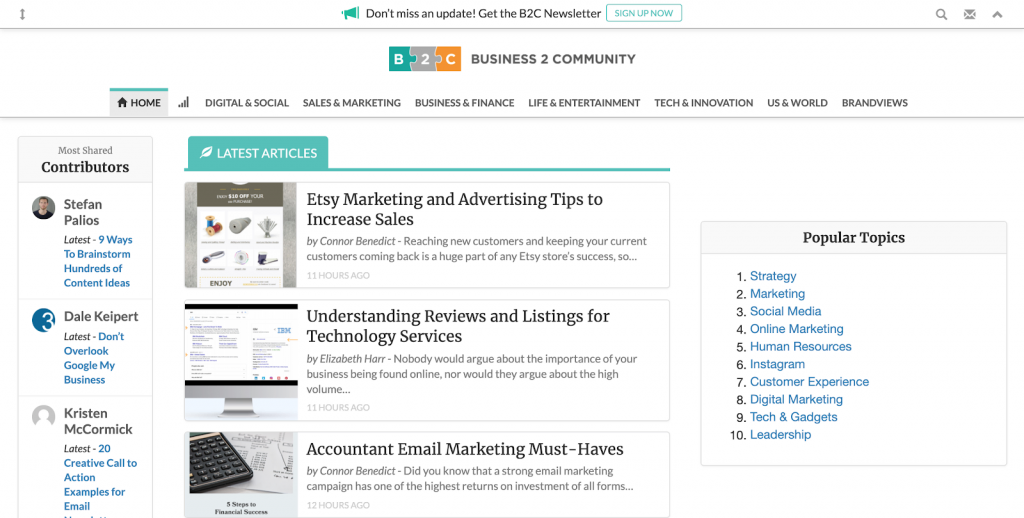
What Makes a Great Blog?
If you want to start a blog, it can be helpful to know what makes an excellent one in the first place. Typically, you can expect to find the following elements in a great blogging site:
High-Quality Blog Posts
People visit a blog to read its content and gain useful information. Therefore, an excellent blog site provides knowledge and inspires users to take action.
When it comes to blog posts, they can differ from one niche to another. However, a great post generally caters to the target audience’s needs, usually by:
- Answering the most common questions people ask about the topic.
- Providing a practical guide for readers to follow.
- Using a language style and format that the audience can understand effortlessly.
A good article should also display originality – it can bring up a unique angle or information that other blogs have yet to cover. This writing method can make your blog stand out from the crowd and establish it as a trustworthy voice within the industry.
Below is a list of other common characteristics in a great blog post may have:
- Well-researched. The content goes beyond surface-level information and provides sound evidence to arguments.
- Organized. It uses headings and subheadings to organize the ideas and make the information flow naturally. It may also have a table of contents for easier navigation.
- Readable. The formatting makes the content easy to scan and digest. This can be done by using short paragraphs, active sentences, and unordered and ordered lists.
- Related imagery. The author uses pictures or video content to make the information more understandable for those preferring visuals.
- Inviting title. It compels potential readers to check out the content. At the same time, it reveals what the article is about without being lengthy.
Besides that, high-quality blog content often pays attention to the best practices of SEO. While doing this won’t directly benefit the reader, it can help the search engines figure out how an article is relevant to users’ interests. That way, the post can reach the right audience.
Typically, an SEO-optimized blog post will include keywords frequently entered by people into the search engines. It may also be written in a longer format of at least a thousand words, which search engines prefer.
Active Reader Engagement
Engagement refers to any type of action taken by the readers when visiting a blog, such as:
- Reading the article from start to finish.
- Exploring a different web page after they finish reading.
- Leaving a comment.
- Sharing the blog post on their social media profiles.
- Signing up on the blogger’s email list.
All these activities can signify that visitors enjoy the content, which is a major sign of a good blog. And what generally inspires people to perform these actions is the blog posts.
Great information can encourage readers to show appreciation to the writer, share the article with their peers, and follow the blogger for upcoming content.
That said, there are other practices that usually urge the audience for such responses, like:
- Posting consistently. Having a regular publishing schedule makes it easy for people to know when to visit the blog for new content.
- Inviting users to comment on the article. Bloggers usually do this at the end of the blog post. When a reader makes a comment, the blog owner will often leave a reply to continue the discussion or show appreciation.
- Encouraging social sharing. Examples include adding social media buttons at the top and the bottom of the blog post or enabling the “Click to Tweet” link for specific quotes within the article.
- Recommending relevant content from the blog. Including interlinks to other articles, accompanied by call-to-action anchor texts inviting users to check these pages out.
Good User Experience
While user experience (UX) isn’t a blog’s main goal, it remains an essential element of a good website. Poor web design and navigation can make it difficult for visitors to explore the content – let alone become a loyal reader.
Although every blog looks different, there are some features they generally share. For instance, a typical blog post layout includes the following elements from top to bottom:
- Header with a navigation menu
- A content area on the right, displaying the article in full
- A left sidebar featuring a description about the blogger, links to other articles, and some call-to-action buttons
- A comment section
- Footer for other navigational links
Bloggers generally don’t stray too far from these conventions as they’re quite familiar to most users. Using this structure will make it easier for new visitors to interact with the content from the get-go.
Take a look at the travel blog Nomadic Matt for an example.
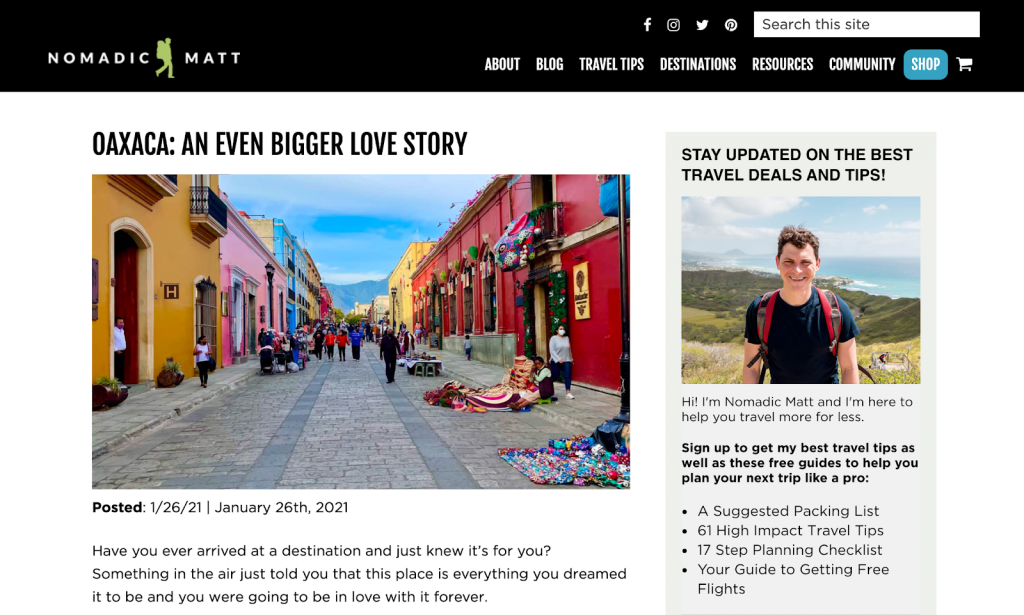
Another important UX element for a good blog is article grouping – the way related blog posts are classed together. The purpose is to help users discover similar content with ease and assist search engines in locating all the pages on the website.
Usually, bloggers group articles together by the topics. The navigation menu typically contains links to these categories so that users can access them from any web page.
A good example of article grouping is the lifestyle blog Brit + Co. The website categorizes posts based on whether they talk about food, fashion, beauty, living, and so on.
Some categories may also contain subgroups. For instance, the food category consists of subtopics like appetizers, DIY recipes, and cocktails. Including these can make the navigation much easier and more efficient.
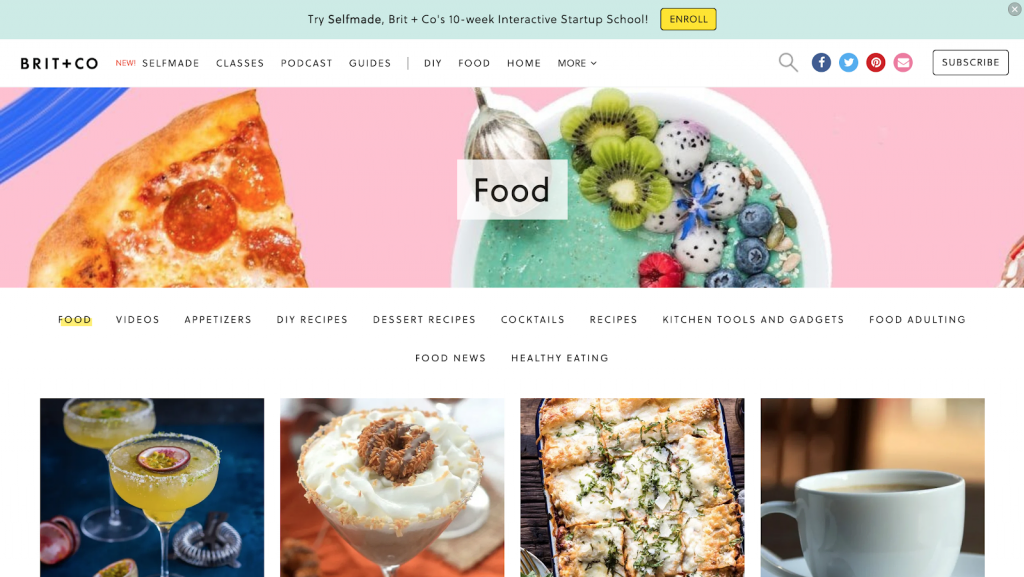
How Do Bloggers Get Paid?
While some choose to blog without making money, many people aim to generate a side or even full-time income from blogging.
How much a blogger can earn widely varies. For instance, Jeremy from Living the Dream makes $4,276/month, a handsome fee for a passive income.
On the other hand, Adam Enfroy generates around $80,000/month, an extremely profitable amount for a small blogging business.
One factor that affects a blogger’s earning is the monetization methods they use. Having more income streams usually leads to a higher salary.
Here are common ways blog owners make money:
- Ad displays. The blogger will work with businesses interested in advertising on their blog. They may sign up on an advertising network, like Google Ads, or approach the companies directly.
- Affiliate marketing. They may join platforms, like Amazon Associates or Skimlinks, which will provide them with links to their partners’ products and services they can feature on their blog.
- Sponsored content. They will establish a partnership with a brand relevant to their target audience and create a blog post specifically to discuss their product or service.
- Sell products and services. Some content creators create physical merchandise for their fans, such as t-shirts or mugs. Digital goods, like eBooks and online courses, are also common.
- Donations via PayPal or Patreon. This is a popular monetization method for bloggers who only seek funding to keep their website alive, such as Captain Awkward.
Another factor that affects a blogger’s income is blog traffic. Generally, blogs with hundreds of thousands of page views have an easier time collaborating with brands and generating sales from their readers.
As such, those who want to start a blog and make money usually have to focus on building their audience first before generating a stable income.
What You Need to Start a Blog
There are many things to prepare if you want to get started with blogging. We recommend beginning with the following elements first:
Website
To create a blog website, you should first decide on the platform you will build it on. One option is to use a content management system, like WordPress.org. It’s a popular choice among personal and professional bloggers, as it’s free and open-source.
Using WordPress requires purchasing a web hosting service to make your blog accessible on the internet. Hostinger offers reliable and user-friendly shared hosting plans starting from $0.99/month, which include a free domain name too – perfect for beginners and small business owners.
WordPress also comes in a hosted version, accessible from WordPress.com. However, this version is paid and comes with fewer customization options.
Alternatively, consider a hosted blogging platform, like Blogger or Tumblr, which are usually more favored by non-commercial blog owners.
Once you decide on the platform, you will need a domain name. This is the URL people will enter in their browsers to open a website.
It’s best to use a short and memorable name that describes the blog’s content. That way, visitors can understand what the website is about from the domain alone. If you’re stuck, this name generator can offer some ideas.
Lastly, a website requires a theme or template, which is a group of files that make up the web design. WordPress users can find thousands of free themes for various blog categories on the WordPress official directory.
Niche
While having a niche isn’t necessary, it is recommended for those who want to start a blog as a business. It can define the scope of the content you’ll produce and ensure that it remains relevant to your target audience.
A blog that tackles multiple niches usually has a more challenging time acquiring a loyal readership. This is because not everyone is going to be interested in the same subjects as the blogger is.
As previously mentioned, a niche can be narrow or broad, depending on the range of topics you want to discuss. That said, it’s best to be specific, especially if you’re picking a popular niche. Doing this will make it easier for the blog to stand out from similar websites.
For instance, the travel blog The Points Guy sets itself apart from other travel niche websites by focusing on using credit card points and airline miles for traveling.
Another example is Nerd Fitness. This website focuses on workout tips and tutorials for nerd culture enthusiasts. Catering to a segmented audience makes it easy to differentiate the blog’s brand from other fitness blogging competition websites.
Content Writing Skills
If you want to write a blog post that the audience will benefit from, it’s good to sharpen your writing skillset beforehand. Here’s what excellent content writing skills usually include:
- Researching – the ability to collect data from trustworthy sources. Doing this will make your blog post much more in-depth and authoritative. Plus, reading existing content on a subject can provide insights into what readers may like and how your content may fare against your competitors’.
- Communication. To build a connection with your target audience, you need to express your ideas in a way that resonates with them. Make sure to organize your thoughts and ideas in a natural and easy way to follow for you and your readers.
- Linguistic accuracy. Mastering your language’s grammar, spelling, and punctuation will make your content easier to understand. Furthermore, it will make the blog look more credible.
SEO Skills and Tools
We have previously emphasized the importance of optimizing blog content for search engines. Without the basic SEO skills, your website won’t appear on search engine result pages (SERPs), which means it won’t be able to reach your target market.
For a beginner’s guide to SEO, we recommend reading this Ahrefs article. WordPress users can also check out this blog post.
Additionally, consider using these tools to help you with SEO:
- Ubersuggest. It’s free web software that’s useful for analyzing competitors, researching keywords, and discovering popular content in your niche.
- Google Search Console. A program that can show the blog posts’ ranking in Google’s SERPs. It can also reveal website performance bottlenecks, which can be an obstacle for SEO.
- Google Analytics. A tool to track website traffic. Additionally, it can provide insights into how users behave around your website – from the total duration they spend on a web page to the number of posts they read.
- Screaming Frog. A website crawler that can look for common on-page SEO issues, such as broken links, redirects, and duplicate content.
- Yoast SEO. A WordPress plugin that will give you a checklist of tasks to complete for your content to rank on SERPs. It can also generate an XML sitemap to make the web pages easier to locate by search engines.
Conclusion
The most common answer to the question “what is a blog?” is “a place where you can talk to your followers.” While this is correct, blogging websites can be used for much more than that.
While many people utilize blogging websites to share information with their followers, businesses usually use them to reach their potential customers via search engines.
Besides explaining a blog’s definition and use cases, we have also covered:
- The difference between a blog and a website
- The five types of blogs
- Elements of a great blog
- Whether bloggers make money
If you would like to create your first blog, make sure to pick the right platform and build an easy-to-navigate website. Additionally, having a set niche, excellent content writing skills, and some SEO knowledge will be beneficial for those interested in personal weblog websites or blogging for business. If you’re still looking for ideas, check out our piece on website ideas!
[“source=hostinger”]









